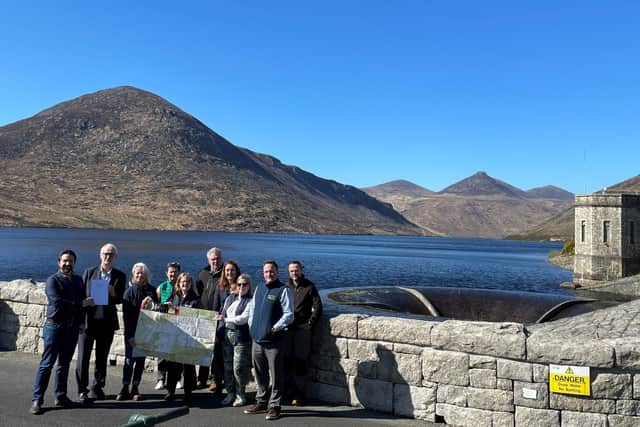Organisations mark second anniversary of Mournes fire with ‘Forever Mournes’ milestone
and live on Freeview channel 276
Representatives from the National Trust, Mourne Heritage Trust, the Woodland Trust and Northern Ireland Water met to sign the document to establish a commitment to work together across their collective land holding and interests in the Mournes and enhance co-operation, build resilience and protect this special landscape, with Northern Ireland Environment Agency (NIEA), Newry Mourne & Down District Council and the Forest Service joining as observer members.
Nearly 300 hectares of land in the Mournes were destroyed by the flames on 23 April 2021. One of the worst hit areas was Slieve Donard, Northern Ireland’s highest mountain and a site that’s designated as a Special Area of Conservation due to the montane and dry heath, blanket bog and specialised species which thrive here.
Advertisement
Advertisement
Heather McLachlan, National Trust director for Northern Ireland and speaking on behalf of Forever Mournes said: “Our organisations have already been working together, as shown through the successful completion of the Mournes Community Renewal Through Nature Project which has produced a number of scoping studies and pieces of research to inform development of more comprehensive and coherent management approaches. There have already been some fantastic projects such as restoring woodland and upland heath in Annalong Valley and path work repair along the Glen River. The benefits of this collaboration became really clear in the aftermath of the fire two years ago, highlighting the increasing danger of wildfires due to the climate emergency.


“We’re excited to have reached this really important milestone in caring for the Mournes as we formalise our commitment to work together and with others to develop a long-term vision for the area, looking at land use, visitor management and infrastructure management to tackle the emerging challenges of a changing climate.
“We want the Mournes to be an inspirational example of sustainable development in action, a place where a sustainable and prosperous economy, world class outdoor recreation, visitor experiences, educational experiences and vibrant communities all come together to sustain and restore the spectacular landscape, its wildlife and natural and cultural heritage. Local people, visitors and the many organisations working in the Mournes or have a contribution to make to it, must be united in achieving this.”
The fire has had a devastating and lasting impact on the surrounding environment which is a precious and scientifically important area, home to a rich variety of wildlife and habitats that need care. The National Trust has been involved in wildfire recovery since 2021 and thanks to funding from Department of Agriculture, Environment and Rural Affairs (DAERA), and support from partners in Forever Mournes further progress will be able to be made to restore the landscape.
Advertisement
Advertisement
Patrick Lynch, National Trust countryside manager says the land has been slowly recovering, but it may take decades for it to be restored to what it was before: “Through carrying out land and drone surveys, National Trust rangers have been able to assess the fire damage and monitor the natural regeneration of the heathland. In some areas you can still see the scorched vegetation and permanent change to habitats. The land has been slowly recovering, but instead of heather and other important heathland plants, we are seeing that swathes of purple moor grass becoming dominant in the areas around Thomas Mountain and a reduction of species diversity. It could take decades for it to be restored to what it was.
“By working in partnership, we can achieve so much more and ensure the mountain gets back to full health as soon as possible for the plants, animals and insects that live there, but also for the many people who love, care for and visit this special place. Next month we plan to introduce cattle to graze the areas of dominant purple moor grass and increase the diversity of the sward and in turn, reduce the fire risk.”
Martin Carey, chief executive at the Mourne Heritage Trust said: “Mourne Heritage Trust has been encouraged by the engagement and commitment of key landowners and agencies through Forever Mournes. Over recent years MHT has built up our understanding and expertise in approaches to management of the pressures impacting on the high Mournes, not least those emanating from continued high levels of outdoor recreation use with visitor counts at 50% above pre-pandemic levels. This work includes erosion control, heathland and peatland restoration, wildfire mitigation and engagement rangering.
“Partnership work is vital to provide the coordination and resources to magnify these approaches to landscape scale, making them proportionate to the pressures impacting on our prized landscape and the eco-system goods and services it provides in respect of clean water, carbon sequestration and health and well-being. In particular, it is important that there is continuity of resource to take the multi-year approach required to address these important issues. As an organisation dependent on piecemeal grant funding, MHT is heartened by the shared commitment to develop long term approaches. We look forward to building on the unity of purpose that has been evident in Forever Mournes to date.”